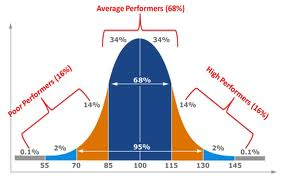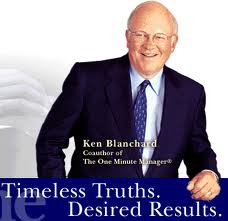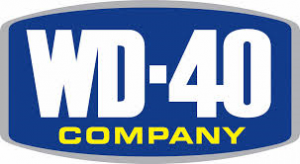Click here to return to Blog Post Intro
Wisdom From: Helping People Win at Work by Ken Blanchard & Garry Ridge (of the WD-40 Company)
In most organizations, managers are expected to rate only a few people high, a few people low, and the rest as average performers. Even when a company doesn’t use the normal distribution curve as a guideline, managers are often afraid to rate all their people high because they would be accused of being “too easy” or “soft”.
Some companies even give elaborate “standard deviation”-like guidance as follows:

Then Ken Blanchard came along… As a college professor, his philosophy was that every student should receive an “A”. To accomplish that, he would distribute the final exam on the first day of class…then teach to it throughout the semester. His goal was to ensure expectations were clear, so everyone could succeed.

The WD-40 Company latched on to this philosophy. Once a year, every leader has a conversation with each of his or her direct reports to establish the final exam, which includes the following three elements:
- Essential functions
- SMART goals
- Values
After a final exam is created, the process goes like this: leaders and team members analyze the development level on each of his or her goals and determine the leadership style that is a match. Then they have to agree on a follow-up plan to implement an agreed-upon style. This is consistent with Blanchard’s teaching on Situational Leadership®. His model is based on two beliefs:
- People can and want to develop.
- There is no best leadership style to encourage that development.
Therefore, managers should tailor their leadership styles to the situation.
At WD-40 Company, daily use of Situational Leadership® II and quarterly informal and formal discussions provide the structure to encourage feedback and praise. Does it work? Yes. In the 2008 WD-40 Company Employee Opinion Survey, 90.5% of the workforce indicated, “My supervisor gives me good ongoing feedback regarding my performance.”

At WD-40 Company, everybody has to complete only one performance evaluation—their own—and they do it every quarter for our informal/formal discussions. This evaluation is based on the final exam they agreed on at the beginning of the fiscal year.
If there isn’t clear evidence that a plan was in place to help the team member get an A…the CEO (Garry Ridge) would question that leader’s commitment. He points out that the company wants to create an empowerment culture rather than a hierarchical, micromanaging culture. This entails removing fear of failure from the organization so that people can get the help they need to achieve an A.
Consistent with the WD-40 philosophy, this responsibility rests not just with the manager, but also with the employee. As Garry Ridge says, “It’s a partnership. Both sides are responsible.” They’re accountable to each other: “We owe each other for something we agreed on.”
“Not everyone gets an A,” Garry says, “but that is the aim.” If someone receives a B, that person plays a major role in that evaluation. Now together, the manager and team member determine what has to be done and what help is needed to get that “A” next time. This takes any fear out of a performance review, because both manager and team member are accountable and responsible.
Leadership that emphasizes judgment, criticism, and evaluation is a thing of the past. Leading at a higher level today is about treating people the right way by providing the direction, support, and encouragement they need to be their best. If you help your people get “A’s”, your performance management system will ignite them to blow away your customers with outstanding service. Why? Because people who feel good about themselves want to return the favor.
So, what are you doing to help your team members “get an A” today? The more team members who “get an A”, the greater your opportunities to shoot for the stars!
